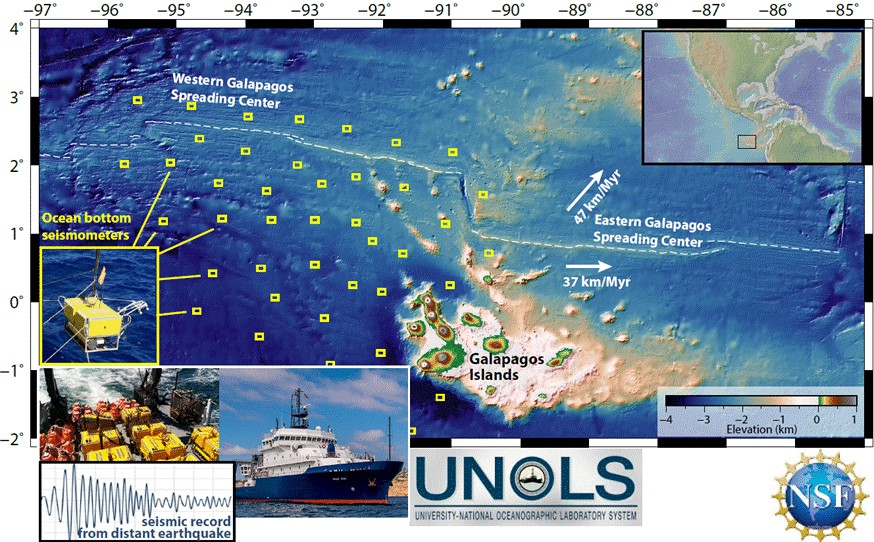
An Open Access Seismic Investigation of Galápagos Plume-Ridge Interaction
Opportunities to Apply to Sail and for Graduate Study
Apply-to-Sail: We are now accepting applications from current graduate students and early-career scientists in the geosciences from U.S. institutions to sail on a marine expedition to recover 53 ocean-bottom seismometers (shown schematically above with yellow boxes) from a seafloor array northwest of the Galápagos Islands, June 11-July 4, 2024.
Graduate studies at the University of Hawaiʻi: In addition to and separate from the above, the Dept of Earth Sciences is accepting applications, from all countries, for graduate studies in this project. The successful graduate student applicant will be invited to join the seagoing expedition and then will engage in research using shear-wave splitting and/or high-performance computing to glean information about mantle convection and magma genesis.
The Galápagos area is a classical example of the interaction between a mid-ocean ridge and an off-ridge mantle plume. Despite over four decades of geologic, geophysical, and geodynamic studies of this area, we still have untested hypotheses and numerous questions about the physical processes by which mantle plume-ridge interaction actually occurs. To address this deficit, our team of geophysicists at the Universities of Oregon (Emilie Hooft, Douglas Toomey), Rhode Island (Yang Shen) and Hawaiʻi (Garrett Ito), is conducting an investigation to tomographically image the seismic velocity structure of the upper mantle between the Galápagos Islands and the Western Galápagos Spreading Center. In Spring 2023, we deployed the seismometer array shows above, which has been recording seafloor vibrations from regional and distant earthquakes. The recovery of the instruments and data we be done onboard the R/V Sally Ride, embarking from Isla de San Cristobal, June 13, disembarking from Isla Santa Cruz July 3. All cruise participants will gain experience in marine geophysical field work, instrumentation, and data management and analysis.
Graduate studies: Individuals interested in pursuing graduate research in shear-wave splitting, high-performance computer simulations of mantle convection, or both should apply to the graduate program in the Dept of Earth Sciences, Univ. of Hawaiʻi by visiting https://www.soest.hawaii.edu/earthsciences/academics/es_graduate.html. Contact Garrett Ito at gito@hawaii.edu for more information. Review of applications will begin December 1, 2023 and will continue until the position is filled.
Please visit https://www.soest.hawaii.edu/GG/FACULTY/ITO/Galapagos_Expedition for complete information about this opportunity.